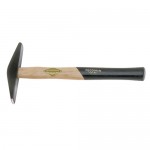Some years ago, my friend and I collaborated on a jewelry booth for our beaded jewelry. To help with our display, she brought in a steel remote control holder in the shape of a flat hand. I just loved that thing. I put it on a stand in front of our trays holding a cool bracelet, and it never failed to get attention. I have been wishing for a display like that lately, to show off my little stacking rings at craft shows. Hmmm... that hand was metal. I'm supposed to be a metal smith. I'm sensing a connection here....
Step 1 - Choose your metal. I chose copper. Why? I have a lot of it. It hammers easily. It looks cool with silver. And I really have a lot of it. Good. That was easy!
Step 2 - Trace your hand onto the metal with a sharpie. Or have someone else trace it for you. Or be sneaky, and trace their hand. Then wash your hand. Wash it some more. Oh hell, it will wear off. You're a metal smith, who cares if you have sharpie marks outlining your fingers? (If you really care, use a nail brush and good soap. It works.) Note - you might be happier if you read to the end of these instructions (see the end of step 7)
before you begin drawing.
Step 3 - Cut out the hand. Shears will do most of the job, but a jeweler's saw is really the ticket in between the fingers. File every edge, allowing no slivers, then follow up with sandpaper. If your copper is a little funky like mine, sand both sides and the edges with 320 grit,and then repeat with 400.
 |
| Partially hammered hand. Can you tell it's mine? |
Step 4 - Pull out a ball peen hammer and your bench block. Put on music with a good beat. This helps. Hammer gently but firmly, beginning with an outer edge, working your way into the center. Let the hammer do the work. It should rise and fall like a machine, while you move the piece beneath the hammer. You can re-hammer an area to increase the density and overlap of hammer blows. Don't hammer so hard that you distort the shape of the piece, but aim for solid blows that leave nice clear marks. (Ear savers: place something under the block to deaden sound - a sand bag, an old mouse pad, a telephone book, an old dish towel, or get creative and make good use of a jewelry supply catalog.)
Step 5 - Curve your hand in the desired direction. The metal will stretch and curve up around your hammer as you strike blows. You can reverse this curve if you want to by flipping the hand upside down and striking it with a mallet on your bench block. It will straighten a bit, become a little harder, and help the hand to curve in the other direction.
 |
| Finished. See the curve in the fingers? |
Step 6 - Curve the fingers if you want to, for strength. You can use nylon pliers for this, especially if they are rounded. Grasp the outer edges of the fingers with the nylon pliers, bending the edges back away from the front of the display. Work your way around the fingers. If you have a wooden swage block (a grooved block), you can lay a copper finger back-side-up in a groove, and hammer a dowel against the back of each finger, pressing it into the groove to help curve it. If your swage block is metal, line it with leather first to keep it from marring your nicely hammered fingers. If you don't have a swage block, you can pretend you do, and file a groove, cut a long notch, or drill a fat groove into a piece of 2x4. and then you really will have a swage block (cool, no?) Or just try malleting a copper finger, from the front, length wise around a handy dowel. Keep adjusting until your rings fit the fingers.
Step 7 - Create a stand for your new custom display by sliding it into a slot you have cut in a piece of wood (which was my solution, because I had a slotted piece of wood on my bench, and nothing better to do with it). My stand still needs to be stained to match the rest of my display. Or pick up a display stand meant for plates, and lean it on that.
Or, if you are the type of person that reads instructions all the way through
first, the way they tried to teach us in school, you could leave a nice long and wide copper tab beneath your hand when you first draw it, and now you can bend that over to create a hand-stand (Get it? Display humor. So sad.)
 |
| Not a great shot, but here it is in my booth. |
So there you have it. your own custom hand display. It looks cool. And if you aren't having much luck selling rings, you can show passers by how it matches your hand, and try to get them to listen to the fact that you made it yourself. This can be entertaining at painfully slow shows. (For you, not the customer. But if it's truly slow, do what you need to survive it. We will understand.)
If you make any displays, please share them with me! I need ideas too.
Happy hammering!!
 Girls in white dresses with blue...
Girls in white dresses with blue...






